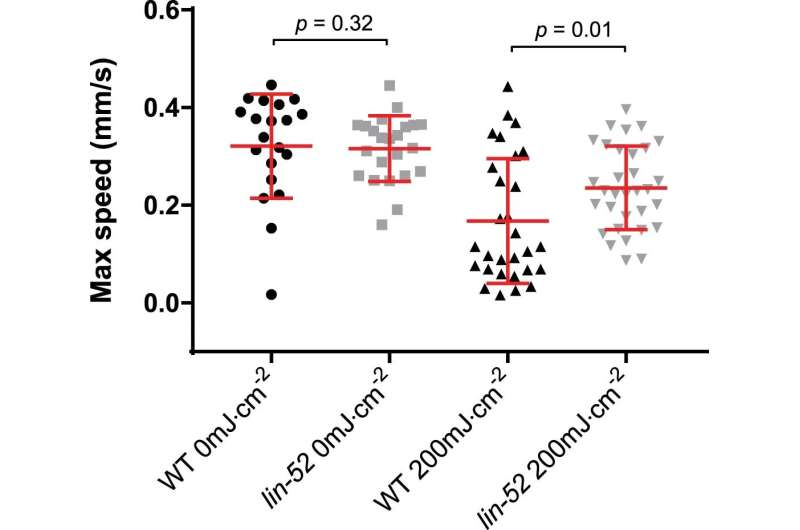This article has been reviewed according to Science X's editorial process and policies. Editors have highlighted the following attributes while ensuring the content's credibility:
fact-checked
peer-reviewed publication
trusted source
proofread
Researchers discover a new way to fight the aging process and cancer development

A protein complex prevents the repair of genome damage in human cells, in mice and in the nematode Caenorhabditis elegans, a team of researchers at the University of Cologne has discovered. They also successfully inhibited this complex for the first time using a pharmaceutical agent.
"When we suppress the so-called DREAM complex in body cells, various repair mechanisms kick in, making these cells extremely resilient towards all kinds of DNA damage," said Professor Dr. Björn Schumacher, Director of the Institute for Genome Stability in Aging and Disease at the University of Cologne's CECAD Cluster of Excellence in Aging Research.
Because it contains all of our genetic information, our DNA must be well protected. However, it constantly faces damage caused by environmental influences—or our normal metabolism. Hence, DNA repair is essential for the stability of our genome and the functioning of our cells.
"Our findings for the first time allow us to improve DNA repair in body cells and to target the causes of aging and cancer development," Schumacher added. Still, more research is needed until these results can be translated into new therapies for human patients. The study 'The DREAM complex functions as conserved master regulator of somatic DNA repair capacities' has appeared in Nature Structural & Molecular Biology.
DNA damage leads to aging and disease
Our genetic material is passed on from generation to generation. That is why it is particularly well protected in our germ cells. Highly precise DNA repair mechanisms are at work there, ensuring that only very few changes in the genetic material are passed on to offspring. Thanks to DNA repair, our human genome has been passed on to us by our ancestors for two hundred thousand years. It has always ensured that the genetic information is preserved. DNA is also constantly repaired in our body cells, but only for the duration of the individual's life.
Sometimes, children are born with faulty DNA repair systems, making them age more quickly and develop typical age-related diseases such as neuro-degradation and arteriosclerosis already in childhood. In some cases, they also have an extremely increased risk of cancer. These are all consequences of DNA damage not being properly repaired.
The DREAM complex prevents repairs
Schumacher and his team explored why body cells do not have the same repair mechanisms as germ cells. In experiments with the nematode C. elegans, they found out that the DREAM protein complex limits the quantity of DNA repair mechanisms in body cells: the complex attaches to the DNA's construction plans containing instructions for the repair mechanisms. This prevents them from being produced in large quantities.
Germ cells, however, do not have the DREAM complex. Hence, they naturally produce large quantities of DNA repair mechanisms.
Mammals also have a DREAM complex
In further experiments with human cells in the laboratory (cell culture), the scientists showed that the DREAM complex functions in the same way in human cells. They were also able to override the DREAM complex with a pharmaceutical agent.
"We were very pleased to see the same effect as we did in C. elegans. The human cells were much more resilient towards DNA damage after treatment," said Arturo Bujarrabal, a postdoc in Schumacher's team and lead author of the study. Treatment with the DREAM complex inhibitor also showed amazing effects in mice: The DNA in the retina of mice could be repaired and the function of the eye preserved.
The test was carried out in mice that, like some patients, age prematurely and show a typical degeneration of the eye's retina.
Genome damage also plays a major role in manned spaceflight because of the extremely high radiation in space. A longer stay in space without improved DNA repair is hardly imaginable. Schumacher says, "Therapies that target and improve this newly discovered master regulator of DNA repair could reduce the risk of cancer because genes remain intact."
In addition, the risk of age-related diseases would be reduced because cells can only fulfill their function with an intact genome.
More information: Björn Schumacher, The DREAM complex functions as conserved master regulator of somatic DNA-repair capacities, Nature Structural & Molecular Biology (2023). DOI: 10.1038/s41594-023-00942-8. www.nature.com/articles/s41594-023-00942-8
Journal information: Nature Structural & Molecular Biology
Provided by University of Cologne





















